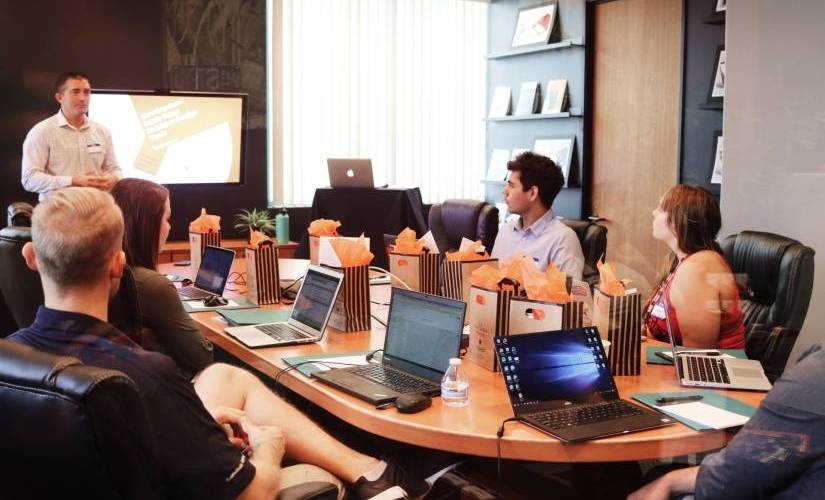The Impact of AI as Companies Address the Skilled Labor Shortage

Due to a combination of Baby Boomer retirements and a declining birthrate leading to smaller subsequent generations like Gen Z — employment firms predict that the talent shortage we’re experiencing now is likely to last for years to come. While this has the potential to be disastrous news for the economy, it doesn’t have to be, thanks to another growing trend in business: AI acceleration.
We’re currently seeing an increase in the application of AI in the workplace that moves beyond typical machines and into areas of law, medicine, software, and even art. While many have predicted that the acceleration of AI would lead to the demise of human labor, it may very well be this technology that solves the labor problem — at least for those willing to work in tandem with these AI solutions.
Taking Advantage of AI
So what does working with these AI solutions look like? What challenges are businesses facing due to this labor shortage, and how can AI help solve them? I’ll answer these questions and offer some strategies on how organizations can best position themselves to take advantage of AI and combat the continued labor shortage.
Bridging the Gap
The growing skilled labor shortage is already baked into the next 15 to 20 years, thanks to existing and continuing demographic trends. However, the opportunities to innovate within the labor shortage space are massive in the areas of cloud computing, AI, and robotics. Investment in these areas can help U.S. companies compete in a world that’s increasingly fractured and regional.
Robotics and AI systems have already proven reliable in repetitive, precise, and dangerous tasks. Businesses transitioning their supply chain away from globalization and toward more regional approaches can use AI to automate many of the tasks necessary in warehouse and factory environments.
Plenty of Use Cases
In construction, AI is being adopted to complete tasks such as drywall installation and painting, allowing humans to focus on more complex jobs such as plumbing and electrical installation.
In industrial projects, remote-controlled machines handle the more dangerous duties, like demolition and movement of heavy materials. For office environments, artificial intelligence and automation are handling repetitive occupations — taking over tasks like data gathering, clean up, and prep.
More Than Mundane
However, repetitive tasks aren’t the only places in which AI prioritization is making a difference. It is being employed to help existing workers do their jobs more effectively and efficiently.
A great example of this is OpenAI’s Codex. Codex is an AI solution that scans and analyzes petabytes of code, questions, and answers from websites like Stack Overflow. With this tool, developers no longer need to search for answers or examples of code. Instead, Codex is directly integrated into the code completion of their IDE, saving them hundreds of hours of searching and increasing their productivity.
Creating More Creative AI
Meanwhile, systems such as Stable Diffusion and ChatGPT show how AI can take over, creating more derivative works and freeing employees up to tackle creative tasks that are still well out of reach of AI.
This isn’t to suggest that AI is an eternal solution to the skilled labor shortage. But it is a critical stop-gap that can be leaned on until the workforce grows again — something that’s projected to happen sometime in the early 2040s.
In the meantime, for organizations to maintain competitiveness as the talent shortage continues, it will be necessary to strategically integrate AI into the labor force wherever possible.
1. Don’t build your entire strategy on top of a third-party AI platform.
While there are speed-to-market benefits to third-party solutions, using the same platforms as your competitors means you’re relying on the same data and, consequently, will wind up with the same business model as everyone else.
By developing your own platform — at least in some use cases — and focusing on the data within your niche instead, you can create a cone of differentiation that protects your business and creates long-term opportunities within your niche market. This will also ensure you don’t get trapped within the vision of a third-party company rather than following your own.
2. Invest in skills acquisition over education.
To combat the skilled labor shortage, you don’t need more employees with general education. Instead, you need candidates with specific skills who can help you close the widening skills gap. Technology certifications such as AWS, Azure, and GCP are great examples of the skills required to build the necessary cloud solutions and AI platforms you’ll need to compete.
This focus on skills isn’t just about hiring. It’s also about changing your focus on internal employee training. Apprentice and licensing approaches like those used for electricians and plumbers are great models for training people in new skills as they’re needed.
3. Align your investments with global shifts in geopolitics, economy, supply chain, and demographics.
As the U.S. and the rest of the world move toward more regionalized supply chains and manufacturing, the combination of human creativity and advanced technology, such as AI and robotics, will be critical. But that will only be true if this combination is pointed in the right direction.
Make sure that your investments in AI and skills acquisition are guided by your environment rather than a desire to invest in technology for technology’s sake.
The Necessary Human Touch
In summary, labor shortages, the current supply chain crisis, and inflation that organizations and leaders face will continue to impact their operations over the next few years. The rise of AI-based solutions could be a key technology to help organizations combat those challenges and maintain a competitive edge if they adopt AI solutions and integrate them effectively with their greatest assets: human creativity and problem-solving.
The strategies I outlined will help leaders prioritize as they begin selecting and adopting those AI solutions and navigate the current and growing issues associated with the shift from globalization to regionalized supply chains and labor.
Realizing AI’s Vast Potential
It’s important to remember that today’s artificial intelligence and automation solutions are designed to enhance human capabilities and improve their potential to solve problems and create explainable knowledge. They aren’t meant to replace humans in the workforce.
Leaders who remember this and focus on the symbiosis of human creativity and AI rather than on using AI to replace people will have a strategic advantage in the decades to come.
Featured Image Credit: Provided by the Author; Unsplash; Thank you!
The post The Impact of AI as Companies Address the Skilled Labor Shortage appeared first on ReadWrite.
(11)







